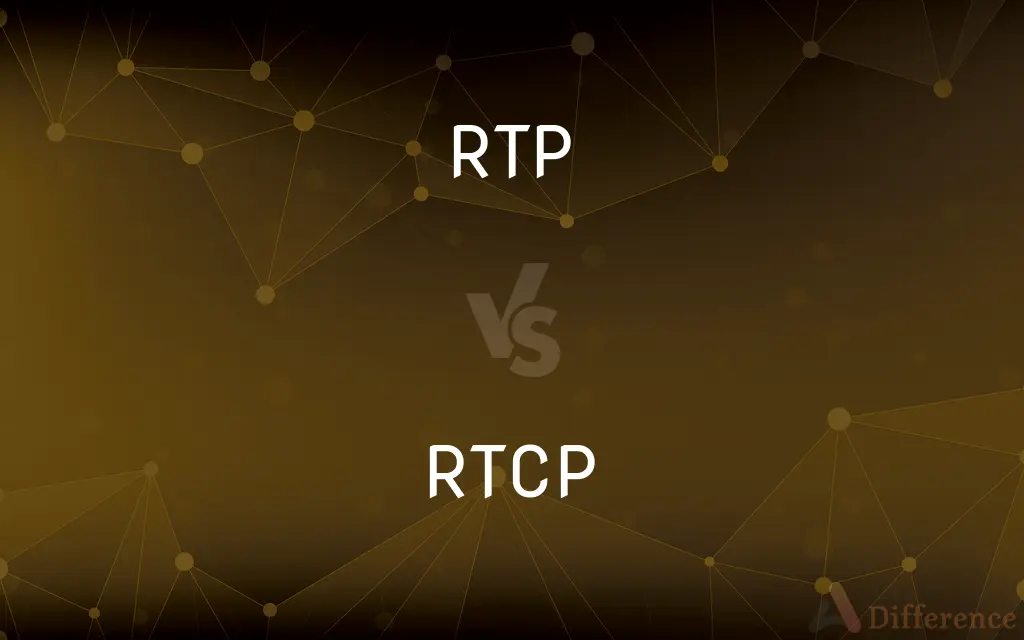RTP vs. RTCP — What's the Difference?
By Tayyaba Rehman & Urooj Arif — Published on February 6, 2024
RTP (Real-time Transport Protocol) is used for delivering audio and video over IP networks, while RTCP (Real-time Transport Control Protocol) provides out-of-band control and monitoring for RTP.

Difference Between RTP and RTCP
Table of Contents
ADVERTISEMENT
Key Differences
RTP (Real-time Transport Protocol) is primarily designed for delivering audio and video over IP networks in real-time. It is used extensively in streaming media systems, video conferencing, and push-to-talk applications. RTCP (Real-time Transport Control Protocol), on the other hand, works alongside RTP to provide out-of-band control and monitoring for RTP streams. It helps in managing the quality of service (QoS) and provides mechanisms for synchronizing different streams.
In the context of RTP, it is important to consider its role in ensuring timely delivery of multimedia content. RTP packets carry the media stream, and its protocol design prioritizes the timeliness over reliability. Conversely, RTCP does not carry media data but instead sends control packets to participants in a streaming session. RTCP packets provide feedback on the quality of the data distribution, including packet loss, jitter, and the presence of other participants.
RTP is designed with minimal protocol overhead to avoid delays in the transmission of streaming media. It includes sequence numbers and timestamps in the packets to handle packet reordering and synchronization. RTCP, in contrast, is not concerned with media delivery but focuses on the monitoring and management aspects. It regularly transmits control packets to all session participants, providing necessary information for effective media streaming.
Another key aspect of RTP is its flexibility to be used with different underlying transport protocols, though it is most commonly used with UDP for faster delivery. RTCP complements this by providing the necessary feedback mechanism, regardless of the transport protocol used by RTP. RTCP reports are essential for adaptive streaming, where the quality of the media stream is adjusted based on network conditions.
RTP does not include any mechanism for signaling or session management. It relies on external protocols, like SIP (Session Initiation Protocol), for these purposes. RTCP, while it also doesn't provide signaling capabilities, plays a crucial role in session management by enabling the continuous monitoring of the session quality, which can be used to make adjustments in real-time.
ADVERTISEMENT
Comparison Chart
Primary Function
Delivers audio and video data.
Provides control and monitoring.
Data Handling
Carries media stream.
Sends control and feedback messages.
Protocol Overhead
Designed for minimal overhead.
No media delivery, focuses on feedback.
Usage with Transport Protocols
Commonly used with UDP.
Complements RTP, independent of transport protocol.
Role in Session Management
Relies on external protocols for session initiation.
Crucial for quality monitoring and adjustments.
Compare with Definitions
RTP
Allows packetized data transmission over IP networks.
RTP packets carry the audio data in our internet radio service.
RTCP
Provides out-of-band control and statistics for RTP sessions.
We used RTCP to adjust the bitrate of our stream dynamically.
RTP
Protocol for real-time transmission of multimedia data.
The live stream uses RTP for efficient video delivery.
RTCP
Offers feedback on transmission quality for RTP streams.
The RTCP feedback was instrumental in diagnosing network issues.
RTP
Facilitates streaming media in conferencing applications.
Our video conference utilizes RTP for real-time communication.
RTCP
Complements RTP by providing session control.
Alongside RTP, RTCP ensures a smoother streaming experience.
RTP
Supports media streaming with minimal delay.
For live sports streaming, RTP is the preferred protocol.
RTCP
Protocol for monitoring RTP packet delivery.
The RTCP reports showed minimal packet loss during the transmission.
RTP
Provides end-to-end network transport functions.
RTP ensures the audio is synced with the video in our broadcast.
RTCP
Facilitates participant synchronization in streaming media.
RTCP helps in synchronizing audio and video tracks in the broadcast.
Common Curiosities
What is RTP used for?
RTP is used for delivering audio and video over IP networks in real-time, commonly in streaming and conferencing.
What kind of data does RTP carry?
RTP carries the actual media data, such as audio and video packets.
Can RTP be used over TCP?
While RTP is commonly used over UDP for lower latency, it can be used over TCP in scenarios requiring reliable delivery.
Does RTCP help in reducing latency?
RTCP helps in managing the quality of the stream, which can indirectly affect latency but is not primarily designed for latency reduction.
Is RTCP necessary for all RTP streams?
While not mandatory, RTCP is highly recommended for effective management and monitoring of RTP streams.
How does RTCP complement RTP?
RTCP provides out-of-band control and monitoring for RTP streams, helping in quality management and synchronization.
Can RTP work without RTCP?
Yes, RTP can operate without RTCP, but RTCP enhances media streaming by providing quality feedback and control.
How does RTCP assist in synchronization?
RTCP assists in synchronization by providing timestamps and other information to align audio and video tracks.
What does an RTCP packet contain?
RTCP packets contain control information, feedback on stream quality, and participant information.
How does RTP handle packet loss?
RTP itself does not handle packet loss recovery, relying instead on underlying protocols or application-level solutions.
Can RTP be used for non-live applications?
Yes, RTP can be used for non-live applications but is optimized for real-time, live transmissions.
Is RTP secure?
RTP itself does not include encryption, but it can be secured using protocols like SRTP (Secure Real-time Transport Protocol).
How frequent are RTCP packets sent?
The frequency of RTCP packets depends on the session configuration and network conditions.
Does RTCP transmit media data?
No, RTCP does not transmit media data; it transmits control and feedback messages.
Are RTP and RTCP suitable for all types of networks?
RTP and RTCP are versatile but perform best in networks with adequate bandwidth and low latency.
Share Your Discovery

Previous Comparison
Calories vs. Fat
Next Comparison
Peanut Butter vs. JellyAuthor Spotlight
Written by
Tayyaba RehmanTayyaba Rehman is a distinguished writer, currently serving as a primary contributor to askdifference.com. As a researcher in semantics and etymology, Tayyaba's passion for the complexity of languages and their distinctions has found a perfect home on the platform. Tayyaba delves into the intricacies of language, distinguishing between commonly confused words and phrases, thereby providing clarity for readers worldwide.
Co-written by
Urooj ArifUrooj is a skilled content writer at Ask Difference, known for her exceptional ability to simplify complex topics into engaging and informative content. With a passion for research and a flair for clear, concise writing, she consistently delivers articles that resonate with our diverse audience.













































